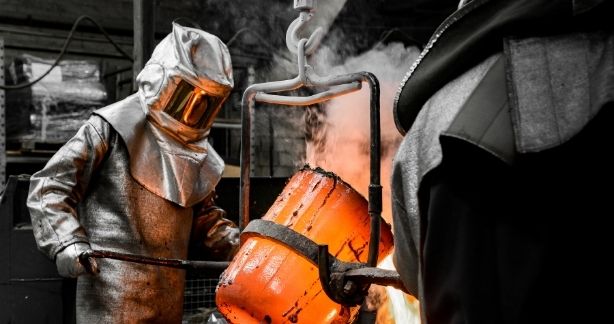As a blacksmith, jewelry-maker, or any other type of craftsman who works with precious metals, you must be familiar with the exact melting points of certain metals before you start working with them. If you’re trying to melt down precious metals and alloys, knowing their melting points will help you predict how hot you need to burn your forge. Keep reading for a brief guide to the melting points of precious metals that many blacksmiths commonly use.
Gold
The melting point of gold typically increases as its number of karats increases. For example, 24K pure gold has a melting point of 1,945 degrees Fahrenheit or 1,063 degrees Celsius, while 10K gold has a melting point of 1,665 degrees Fahrenheit or 907 degrees Celsius.
Silver
There are several types of silver, including pure, sterling, and coin silver. Each has a slightly different melting point:
- Pure silver melting point: 1,761 degrees Fahrenheit or 961 degrees Celsius
- Sterling silver melting point: 1,640 degrees Fahrenheit or 893 degrees Celsius
- Coin silver melting point: 1,615 degrees Fahrenheit or 879 degrees Celsius
For this reason, make sure you pay close attention to which variety of silver you’re working with so that you know its exact melting point.
Platinum
Platinum melting points can also vary depending on the purity of the metal. Platinum may be combined with iridium at an 85:15, 90:10, or 95:5 ratio of platinum to iridium, respectively. Here’s the breakdown of these:
- Pure platinum melting point: 3,224 degrees Fahrenheit or 1,773 degrees Celsius
- 85% platinum, 15% iridium: 3,310 degrees Fahrenheit or 1,821 degrees Celsius
- 90% platinum, 10% iridium: 3,250 degrees Fahrenheit or 1,788 degrees Celsius
- 95% platinum, 5% iridium: 3,235 degrees Fahrenheit or 1,779 degrees Celsius
Iridium
Iridium itself, without the platinum inclusion, has a high melting point of 4,449 degrees Fahrenheit or 2,454 degrees Celsius, which explains the heightened melting point of higher iridium-to-platinum ratios.
Iron
It’s not a precious metal, but iron is still a valuable ore to blacksmiths. Iron makes up many metalworking projects and crafts, whether you use it as a blacksmith or a bladesmith. The melting point of iron rests in the middle of the precious metals at 2,802 degrees Fahrenheit or 1,539 degrees Celsius.
Copper
Copper is another example of a nonprecious metal that blacksmiths often work with. Note for your future projects that the melting point of copper is fairly high at 1,981 degrees Fahrenheit or 1,083 degrees Celsius.
These are some examples of the most common precious metals that blacksmiths, bladesmiths, jewelers, and more often work with. We hope this brief guide to the melting points of precious metals prepares you for your next smelting project. And if you need smelting equipment, look no further than Cast Master Elite, where you can find all the items you need to stock your forge.






